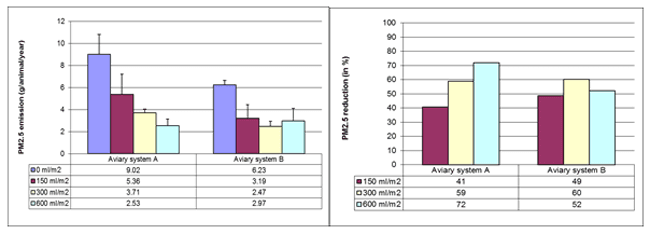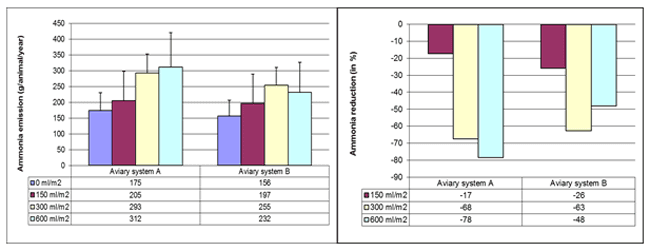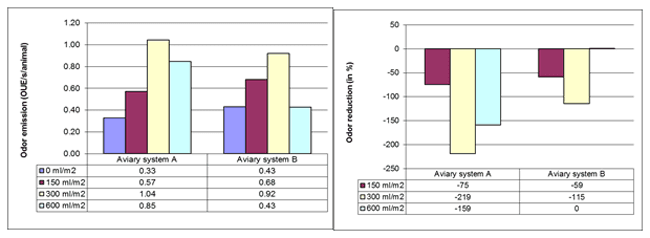Introduction
Measures need to be taken in the Netherlands to reduce emissions of fine dust (PM10 and PM2.5) from major emission sources, including poultry houses with litter, to comply with European standards on maximum fine dust concentrations in the ambient air. The contribution of animal houses, especially poultry houses, to the total primary emission of PM in the Netherlands is estimated to be approximately 20% (CBS et al., 2009). Since 2009 a variety of farm mitigation measures for dust emissions have been developed for different poultry categories in an extensive research and development program (Ogink et al., 2010). However mitigation options for laying hen houses were so far restricted to end of pipe solutions that do not affect the very high PM10 concentrations within barns. There is a need for mitigation technology that decreases both PM10 concentrations within laying hen barns and PM10 emissions at affordable costs.
Spraying water on the litter floors of aviary housing systems for laying hens could be a (cost) effective mitigation option. By the humidification of the top layer of bedding material, dust generation by animal activity will decrease as potential dust particles adhere to the litter surface. The water spraying effect may be similar to the application of an oil film on litter of broiler houses as earlier developed by Aarnink et al. (2009), but has the advantage of substantial lower operational costs by using water instead of rapeseed oil. However, the humidification may increase ammonia and odor emission. We hypothesized that these effects may be controlled by spraying not more water than required for dust control and by applying limited amounts at an adequate spraying frequency.
The objective of this study was to investigate the effect of spraying different doses of water on the litter of two aviary housing systems of laying hens. The effects were determined for the emissions of fine dust, ammonia and odor. The effects on performance, litter quality, animal behaviour (scratching and dust bathing), foot pad condition and plumage condition were studied as well.
Materials and Methods
The study was performed in eight climate separated rooms of the natural ventilated layer house P4 of the experimental poultry farm ‘Het Spelderholt’ in Lelystad, the Netherlands. Four of the eight rooms were furnished with an aviary system with non-integrated nestboxes (A), the other four with a portal aviary system (B). In total 620 and 604 laying hens (Lohmann Brown Lite) were placed in each of the four rooms of A and B aviary system, respectively (van Harn et al., 2011). Table 1 shows the treatments that were applied in both aviary systems.
Table 1. Water spraying treatments.
Each treatment was replicated once per aviary system. Treatments were randomly allotted to the rooms. The experiment was carried out over a period of 34 days from 30 July to 2 September 2010 (age laying hens: 213–237 days). At the start of experiment (day 1) the litter in all rooms was replaced by standardized litter from one batch to ensure equal starting conditions. After an adaptation period of 10 days, the spraying treatments were applied for a period of 25 days (days 10 – 35).
The water film was applied manually using a battery backpack sprayer (SOLOR Type 416, SOLO Kleinmotoren GmbH, Germany, 20 L) and a spraying beam equipped with double nozzles. Water was fogged at a pressure of 2.65 bar, resulting in a water application rate of 1.55 l per minute. The daily amount was sprayed at 08:00 and 15:00.
Mean concentrations and emissions of PM10 and PM2.5 were determined on days 19, 26 and 33 of the experimental period over a period of 24 hours in all rooms. PM10 and PM2,5 concentrations were determined gravimetrically, using stationary sampling pumps (Charlie HV, Ravebo Supply B.V., Brielle, the Netherlands) and cyclone samplers (URG Corp. Chapel Hill, USA), following CEN-EN 12341 for PM10 and CEN-EN 14907 for PM2.5. Unloaded and loaded filters were weighed under standardized conditions (20 ± 1°C and 50 ± 5% relative humidity), following CEN-EN 14907. The PM mass concentration was calculated by dividing the filter load by the volume of air drawn through it. PM10 concentrations were calibrated to the reference impaction sampler described in CEN-EN 12341 using the equations reported by Zhao et al. (2009).
Simultaneously with the dust measurements mean concentrations and emissions of NH3 over the 24 hours sampling periods were determined by using an impinger method. Sampled air was continuously drawn at a fixed flow rate, controlled by a critical orifice (1 l min-1), through a pair of serial connected impingers (0.5 l each) containing an strong acid solution (nitric acid, 0.03 - 0.2 M), and ammonia concentrations determined in the impinger liquid. On day 26 the odor concentrations and emission were determined. Between 10:00 and 12:00 hours in all rooms odor samples were drawn in 40 liter Nalophane bag according to the lung principle. Odor concentrations were measured within 24 hours by the European olfactometric method (EN13725) in an accredited odor laboratory.
On all measurement days a 24 hour average air sample was taken in 40 liter Nalophane bag and analysed for CO2-concentration. This concentration was used to determine ventilation rates of the naturally ventilated rooms on basis of the CO2 mass balance method. The CIGR equations (Pedersen et al., 2008) were used to predict the metabolic CO2 production of the hens.
Productive results (number and quality of eggs; mortality) were determined each day. Behaviour (scratching and dust bathing), foot pad condition and plumage condition were observed on days 7, 17 and 31 of the experimental period. Litter samples for determination of dry matter (DM) content of litter were collected at the beginning and end of the spraying period in all rooms (day 10 and 34).
Emission data were statistically analysed using the REML procedure of Genstat (2010). Emissions on normal scale were explained by a regression model that included water dosing as a variable, aviary system and day numbers as fixed effects, and rooms as random effects.
Results and discussion
Figures 1 and 2 show the treatment effects on the emission of PM10 and PM2.5. Spraying 150 ml m-2 water resulted in overall mean reductions of PM10 and PM2.5 emissions of 18% and 44%, respectively, compared to the reference rooms without spraying. An increase of the amount of water sprayed on the litter floor resulted in a proportional increase of mean reductions. Spraying 300 ml m-2 resulted in PM10 and PM2.5 emission reduction of 48% and 59%, while 600 ml m-2 resulted in a reduction of 64% for both PM10 and PM2.5. The statistical analyses showed a negative linear effect of spraying on both PM10 and PM2.5 emission (P<0.05). Responses on spraying showed a similar pattern between both aviary systems.
Figure 1. Mean PM10 emissions (g/animal/year) and standard deviations (error bars) per aviary system and spraying treatment (left side) and reductions in PM10 emissions as a proportion (%) of the reference treatment (right side).
Figure 2. Mean PM2.5 emissions (g/animal/year) and standard deviations (error bars) per aviary system and spraying treatment (left side) and reductions in PM2.5 emissions as a proportion (%) of the reference treatment (right side).
Spraying twice daily water on litter floor resulted in a clear increase of ammonia emission (fig. 3). Spraying 150, 300 and 600 ml m-2 water resulted in a mean increase of ammonia emission with 21%, 65% and 64%. The statistical analysis showed a positive linear effect of spraying on ammonia emission (P<0.05). The odor emissions (fig. 4, single day observation) also demonstrated an increase with spraying, but this increase was not significant.
Spraying water on the bedding material had a negative effect on the litter quality. The litter was less dry and less friable. DM content at day 10 (start of spraying treatment) was similar between rooms (79.2% - 80.0%), and remained stable in the reference rooms with a value of 79.6% at day 34. Mean values for spraying treatments 150, 300 and 600 ml showed a decreasing effect on DM at day 34, being 76.5%, 75.2% and 69.2% respectively.
Figure 3. Mean ammonia emissions (g/animal/year) and standard deviations (error bars) per aviary system and spraying treatment (left side) and reductions in ammonia emissions as a proportion (%) of the reference treatment (right side).
Figure 4. Odor emissions (OUe/s/animal/year) per aviary system and spraying treatment (left side) and reductions in odor emissions as a proportion (%) of the reference treatment (right side).
Due to the worse litter quality smoothening of the plumage and foot pad occurred. The severity of the smoothening of the plumage and foot pads increased with water dose and the percentage of laying hens displaying scratching behaviour decreased. The reduced litter quality had no adverse effect on plumage condition and dust bathing behaviour of the laying hens. Spraying water on the bedding material had no effect on the mortality rate, laying percentage, percentage of second grade eggs and percentage of floor eggs. During the limited experimental period, a clear effect of water spraying on dust emission was demonstrated. The data show that the humidity of litter is a factor to take into account in research on dust generation and mitigation options. Given the shown extent of effects of manipulation of the litter top layer by humidification, this approach might be useful as a practical dust mitigation tool. However, even at the lower application rates ammonia emissions could not be controlled. Increasing the frequency of application or the use of water additives that block ammonia emissions could be possible solutions to minimize ammonia formation and emission.
Conclusions
It is concluded that the investigated principle can be an effective technique to reduce fine dust emissions from aviary houses, but that additional measures need to be taken to control extra ammonia emission before this option can be implemented in practice.
Acknowledgements
We want to acknowledge the Ministry of Economic Affairs, Agriculture and Innovation of the Netherlands for financing this study.
Citation
“Top layer humidification of bedding material of laying hen houses to mitigate dust emissions: effects of water spraying on dust, ammonia and odor emissions” by Nico W. M. Ogink, Jan van Harn, Rick van Emous, and Hilko Ellen. Paper No. ILES12-0528.
Presented at the Ninth International Livestock Environment Symposium, sponsored by ASABE.. This is an ASABE publication and it is reproduced with their permission.
References
Aarnink, A.J.A., J. van Harn, A. Winkel, F.E. de Buisonjé, T.G. van Hattum and N.W.M. Ogink. 2009. Dust reduction in poultry houses by spraying rapeseed oil. In: Joint International Agricultural Conference 2009, Wageningen, The Netherlands, July 6-8, 2009. - Wageningen : Wageningen Academic Publishers, Joint International Agricultural Conference 2009, Wageningen, The Netherlands, 2009-07-06/ 2009-07-08
CBS, PBL, and WUR. 2009. Emissies van fijn stof, vluchtige organische stoffen en koolmonoxide 1990-2009 (Emissions of fine dust, volatile organic compounds and carbon monoxide 1990-2009, in Dutch). Centraal Bureau voor de Statistiek, Planbureau voor de Leefomgeving, Wageningen University and Research Centre. Available at: http://www.compendiumvoordeleefomgeving.nl. Accessed 1 June.
Genstat Committee. 2010. GenStat Thirteenth Edition, Version-13.2.0.4682. VSN International Ltd, Hemel Hempstead, UK
Harn, J. van, H.E. Ellen, R.A. van Emous, J. Mosquera Losada, G.M. Nijeboer, F.A. Gerrits, A.J.A. Aarnink en N.W.M. Ogink (2011). Maatregelen ter vermindering van fijnstofemissie uit de pluimveehouderij: effect van een waterfilm op het strooisel op de fijnstofemissie bij leghennen in volièresystemen (Measures to reduce fine dust emission of poultry barns: effect of top layer humidification on fine dust emissions of aviary houses with laying hens, in Dutch). Rapport 425, Wageningen UR Livestock Research.
Ogink, N.W.M., A.J.A. Aarnink, J. Mosquera and A. Winkel. 2010. Development and testing of technical measures for the abatement of PM10 emissions from poultry housings. In: XVIIthWorld Congress of the International Commission of Agricultural and Biosystems Engineering (CIGR), Québec City, Canada, 13 - 17 June, 2010. - Québec City, Canada : Canadian Society for Bioengineering, CIGR XVIIth World Congres, Québec City, Canada, 2010-06-13/ 2010-06-17
Pedersen, S., V. Blanes-Vidal, M.J.W. Heetkamp, and A.J.A. Aarnink. 2008. Carbon dioxide production in animal houses: A literature review. Agricultural Engineering International: CIGR Ejournal, Manuscript BC 08 008, Vol. X. December, 2008
Zhao, Y., A. J. A. Aarnink, P. Hofschreuder, and P. W. G. Groot Koerkamp. 2009. Evaluation of an impaction and a cyclone pre-separator for sampling high PM10 and PM2.5 concentrations in livestock houses. J. Aerosol Sci. 40(10):868-878.















.jpg&w=3840&q=75)